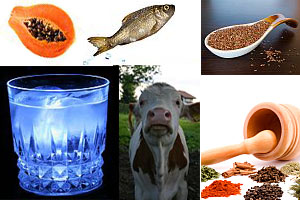Do You Know the Top Foods for Healthy Joints?
Keeping our joints healthy is one of the most important things we can do to remain independent and active as we age. Life can become quite challenging for individuals who are immobilized by joint pain, since it can result in reduced physical and social activity as well as a higher risk of psychological and emotional problems.
When it comes to joint health, exercise is very important, but what you EAT also plays a significant part. Here are some of our favorite joint-friendly foods:
Water — Perhaps the single-most important “food” is water. This liquid is essential for maintaining every system within the body. Water helps in the elimination of toxins, including those poisons that can create joint pain. Water also helps in the delivery of nutrients to the various parts of the body and—like the oil in your car—is essential for joint lubrication. Drink plenty of water every day!
Fish — Cold water fish, such as salmon, mackerel, sardines, white tuna, halibut and trout can deliver healthy doses of omega-3 from the fish oil in each serving. Omega-3 fatty acid is known to reduce inflammation that can cause or increase joint pain. Fish oil can also slow down cartilage degeneration. Cartilage is the rubbery substance between bones that allows for smooth movement. When this wears out, movement becomes extremely painful.
Dairy products — In addition to contributing to bone health, dairy products (and particularly low-fat ones) such as cottage cheese, yogurt and milk can also help eliminate painful gout symptoms.
Flax Seeds — Flax is another source of omega-3 and omega-6 fatty acids for great joint health. Flax seeds and flax seed oil are high in antioxidants, which help to prevent or delay some effects of aging. Flax also contains lots of fiber, which can help you feel fuller for a longer time, reducing the likelihood of snacking. Frequent snacking can lead to obesity—a condition frequently associated with joint pain.
Spices —Curry, ginger and cinnamon also have anti-inflammatory properties that can help your joints. Turmeric has been shown to be particularly effective in reducing the symptoms of osteoarthritis. With these spices in the mix, a joint-friendly diet certainly doesn’t have to taste bad or be bland.
Papaya —The Annals of Rheumatic Diseases published a 2004 study showing a strong correlation between low vitamin C intake and rheumatoid arthritis. Those with the lowest vitamin C consumption were 3 times more likely to develop the disease. Though orange juice has a good dose of vitamin C, papaya has nearly twice as much. Not only that, papaya also includes a good dose of beta carotene for even more anti-oxidant joint support.
Tart cherry juice — The anthocyanins contained in this juice are powerful anti-inflammatories that have been shown to reduce arthritis-related inflammation even better than aspirin. In addition, cherry juice is effective in reducing the painful symptoms of gout.

